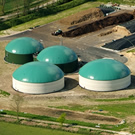
The biogas, consisting mainly of methane (at least 50 %) and carbon dioxide, it arises as a result of a bacterial process of anaerobic fermentation of organic material of vegetable and animal origin.
The Community legislation (Dir. 2001 /77/CE ) and national (D. Lgs 387/03) on the promotion of renewable sources explicitly includes among them the "landfill gas, sewage treatment plant gas and biogases".
As a matter of fact, all three kinds of gases are of biogas, but their separate listing in callback legislation highlights the variety of organic matrices from which the biogas can be produced: waste disposed in landfills or organic fraction municipal waste, sewage sludge, manure, animal waste, organic waste agro-industrial, crop residues, energy crops.
Biogas has a very good calorific value given the high methane content, to which it lends itself to a energy valorisation for direct combustion, implemented in the boiler for only the production of heat, or in engines coupled with generators for the production of electricity or for the cogeneration of electricity and heat.
The thermoelectric plants powered by biogas then carried out the conversion of the thermal energy contained in the biogas, into mechanical energy and then into electrical energy.
In the very common case of plants powered by biogas produced from landfill sites in municipal waste, the main parts of the plant are the following:
- Extraction section of the biogas from landfill(wells of uptake, transport lines, collectors of grouping);
- Intake section and conditioning of the biogas from landfill(general collector, condensate separators, filters, extractors);
- Section of production of the electric energy (generators) and torch (safety device to burn any biogas does not burned in the section of energy production).
In the case of biogas is not derived from landfill, the diagram provides, in place of the extraction section, a section of production (digester) and collection (gasometer) of the biogas, then sent to power generators to produce electrical energy.








